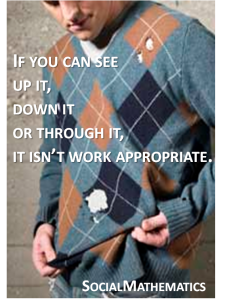No matter who you are, no matter what sub-culture you are living in:
You are making a statement no matter what you choose to wear.
Did you know that your interviewer makes a decision about you within the first two minutes of meeting you? What you wear, how you hold yourself, your hand shake and your ability to produce small talk are all vital and necessary parts of the interview process. The color and pattern of your clothing matters too! But very few people will tell you that. There are many subcultures (including mathematics!) who believe that these things don’t matter… but these skills may be more vital to getting a job than your best proof.
Whatever realm you are walking through, there will be societal standards. If I was a math professor, then I might be expected to wear an adult, subdued version of “shabby chic”. But if I walked into the administration building, I might need to add a suit coat or I’ll look like I think I are better than everyone else. “See that, Professor? She thinks she is too good to bother putting on a clean shirt!” This is because I failed to notice that the standards of dressing are different than inside the math department:

Societal standards are different everywhere. Sometimes people do things to stand out and get noticed. For example, if you dyed hair teal, then you should be prepared to join the ranks of teal haired mathematicians! Many of us, though, don’t think about fashion at all. In fact, a company that I once worked for informed all incoming interns of this fabulous phrase:

“But I like my comfortable clothing!” I can hear you say. Dressing to societal standards doesn’t mean you have to be uncomfortable the whole time. My current favorite trick is to buy a business polo from the company I work for. Then I wear it on days when I don’t feel like dressing up. I wear jeans and a company polo. All of a sudden, I look engaged and enthusiastic while I’m at work when I really just wanted to wear my pajamas but this was the next best thing.






